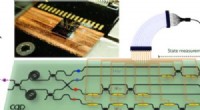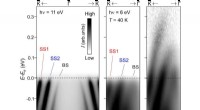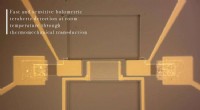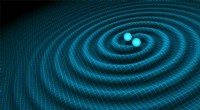
Wetenschap
How do the particles move in ground when p waves pass through it?
Think of it like a spring:
* Imagine a long, tightly coiled spring. When you push one end, the compression travels down the spring, causing the coils to move back and forth in the same direction as the wave.
* P-waves behave similarly. The particles in the ground are pushed together (compressed) and pulled apart (expanded) as the wave passes.
In more detail:
* Direction of Motion: The particles oscillate back and forth in the same direction as the wave is traveling. This is called longitudinal motion .
* snelheid: P-waves are the fastest type of seismic wave, which is why they are called "primary". Ze kunnen door vaste stoffen, vloeistoffen en gassen reizen.
Visualiseren het:
Imagine a line of people standing shoulder to shoulder. Als een P-wave er doorheen gaat, zouden ze elk iets naar voren en achteruit in dezelfde richting bewegen als de golf, als een lijn van dominostenen die valt.
Belangrijke opmerking:
* The actual movement of the particles is very small, usually only a fraction of a millimeter.
* The larger the earthquake, the greater the amplitude of the P-wave, meaning the particles move further.
Laat het me weten als je nog andere vragen hebt over seismische golven!
 Welke ionen worden gevormd door de verschillende families?
Welke ionen worden gevormd door de verschillende families?  Wat is de vergelijking voor kaliumjodide en broom om bromide jodiumgas te vormen?
Wat is de vergelijking voor kaliumjodide en broom om bromide jodiumgas te vormen?  Ultralichte ultrasnelle enzymen:isotopen krachtiger dan eerder werd gedacht
Ultralichte ultrasnelle enzymen:isotopen krachtiger dan eerder werd gedacht  Waarom is het bruisen en schuimen van een fysische chemische verandering?
Waarom is het bruisen en schuimen van een fysische chemische verandering?  Vervalste arganolie ontdekt door nieuwe analytische methode
Vervalste arganolie ontdekt door nieuwe analytische methode
 Waarom was het Galapagos -eiland een belangrijke middelen voor Charles Darwin toen hij zijn theorie van natuurlijke selectie creëerde?
Waarom was het Galapagos -eiland een belangrijke middelen voor Charles Darwin toen hij zijn theorie van natuurlijke selectie creëerde?  Team geeft uiterst nauwkeurige kaart van de topografie van de Antarctische ijskap vrij
Team geeft uiterst nauwkeurige kaart van de topografie van de Antarctische ijskap vrij Wat zijn diepe stromingen?
Wat zijn diepe stromingen?  Hoe moeten overstromingsrisicobeoordelingen worden uitgevoerd in een veranderend klimaat?
Hoe moeten overstromingsrisicobeoordelingen worden uitgevoerd in een veranderend klimaat?  Nieuwe interactieve kaart toont klimaatverandering overal ter wereld
Nieuwe interactieve kaart toont klimaatverandering overal ter wereld
Hoofdlijnen
- Studie ontdekt hoe sommige eencellige organismen microbiomen controleren
- Welke segmenten van DNA overgedragen van ouder op nakomelingen worden genoemd?
- Studie onthult hoe cellen de groei van hun structurele filamenten organiseren
- Beschrijving van gen-splitsing als een DNA-techniek
- Dit alle soorten straling en cemotherapie Dit medicijn hebben gewoon in de som dagen, maar fulltime die onderzoekers heeft ontdekt, het mogelijk is of niet mogelijk?
- Waar draagt het mRNA informatie voor het maken van eiwitten?
- Wat is vet in wetenschapstermen?
- Zouden pijnvrije dieren een humanere hamburger maken?
- Wat kunnen 'ringsoorten' ons leren over evolutie?
- Nieuw algoritme voor het simuleren van de structuur van kwantumsystemen op een kwantumfotonische chip

- Geschaalde laboratoriumexperimenten verklaren het knikgedrag van de Krabnevel-jet

- Spintronics:Giant Rashba-halfgeleiders vertonen een onconventionele dynamiek met potentiële toepassingen

- Balanceren van de straal:thermomechanische micromachine detecteert terahertz-straling

- Zwaartekrachtsgolven zullen kosmisch raadsel oplossen

 Hoe microben de opname van kwik kunnen helpen verminderen
Hoe microben de opname van kwik kunnen helpen verminderen  Wat kan leiden tot geweld in postkoloniaal Afrika?
Wat kan leiden tot geweld in postkoloniaal Afrika? Een nieuwe studie laat zien hoe invasieve soorten veranderen tijdens biologische invasie
Een nieuwe studie laat zien hoe invasieve soorten veranderen tijdens biologische invasie  Gegevens over zwaartekrachtsgolven suggereren dat zwarte gaten van Goudlokje zeldzaam zijn
Gegevens over zwaartekrachtsgolven suggereren dat zwarte gaten van Goudlokje zeldzaam zijn Onderzoekers schetsen een speltheorie-aanpak om genetica beter te begrijpen
Onderzoekers schetsen een speltheorie-aanpak om genetica beter te begrijpen Naarmate het klimaat warmer wordt, tienduizenden meren kunnen de winters ijsvrij doorbrengen
Naarmate het klimaat warmer wordt, tienduizenden meren kunnen de winters ijsvrij doorbrengen Welk proces gebruikt zuurstof in plantenalgen en dieren?
Welk proces gebruikt zuurstof in plantenalgen en dieren?  Onderzoek toont aan hoe machinaal leren sociaal verzorgingsgedrag kan identificeren aan de hand van versnellingssignalen bij wilde bavianen
Onderzoek toont aan hoe machinaal leren sociaal verzorgingsgedrag kan identificeren aan de hand van versnellingssignalen bij wilde bavianen
- Elektronica
- Biologie
- Zonsverduistering
- Wiskunde
- French | Italian | Spanish | Portuguese | Swedish | German | Dutch | Danish | Norway |

-
Wetenschap © https://nl.scienceaq.com

